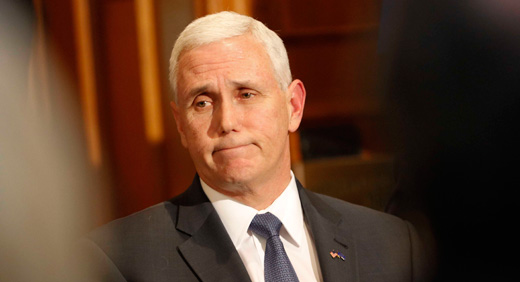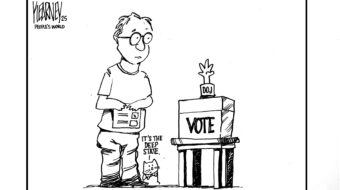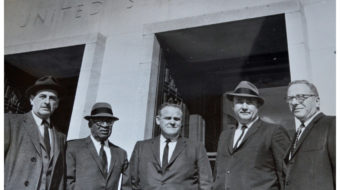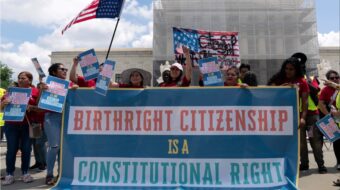
So Donald Trump, after mulling over his gruesome list of possible running mates, has settled on Indiana Governor Mike Pence.
The mass media are discussing the pros and cons of Pence. There are lots of comments about Pence’s reactionary views on economics and labor issues, about his hateful attacks on LGBT folk, his utter disregard for the rights of women, and his willingness to inject religious themes into the presidential election. But there has been little discussion of Pence’s views and past actions on immigrants’ rights, except for some comments that he is not as extreme as Trump on this issue.
This is false. In fact, Pence is a strong enemy of the rights of immigrant workers. Trump and Pence do not “complement” each other on this issue; they echo each other in most respects, only that Pence did not agree with Trump’s idea of barring Muslim travelers to the United States.
When Pence represented his Indiana district in the U.S. House of Representatives, dramatic things were happening in Congress and in the country around immigration.
In late 2005, Congressman James Sensenbrenner (R-Wisc.) introduced, and the House passed, one of the worst, most anti-immigrant bills we have seen in recent years. This was the Border Protection, Anti-Terrorism and Illegal Immigration Control Act of 2005 (HR 4437), known to history simply as “the Sensenbrenner Bill.”
The nation’s political leadership was in an anti-immigrant mood at that time. In 1996, Congress had passed and President Clinton had signed other anti-immigrant legislation that still causes us trouble today: The Illegal Immigration Reform and Immigrant Responsibility Act and the Anti-Terrorism and Effective Death Penalty Act (Clinton complained about some of the anti-immigrant items in this bill, but signed it anyway). The immigrants’ rights movement and its labor and community allies were already fighting back against these laws under the slogan “Fix 96,” one of the themes of the groundbreaking Immigrant Workers’ Freedom Ride of October 2003.
But the Sensenbrenner bill went far beyond any anti-immigration legislation that we had seen in decades. It mandated the construction of a border fence, the arrest by federal officials of all undocumented immigrants detained by local police, and obliged all employers to phase in an electronic system of checking the immigration status of everybody they would hire. It would have fined undocumented immigrants who return after being removed, and imposed 10-year jail sentences for any immigrant using fraudulent documents. It would have made providing housing for an undocumented immigrant a federal felony: This would have encompassed family members and landlords, and also charitable organizations that tried to help families with undocumented members.
In addition, the Sensenbrenner bill would have mandated that organizations and individuals trying to help undocumented immigrants would risk heavy fines and jail terms. It would have blocked immigrants from any country that refused to accept its citizens which the U.S. wanted to deport. There was absolutely nothing in the bill that would have provided legal ways for poor people from poor countries to come to the U.S. legally, or for undocumented immigrants to rectify their status.
The Sensenbrenner bill passed the House by a vote of 239 to 182 with 13 not voting on December 16, 2005. Pence supported the bill and voted for it. Most of the “aye” votes were from Republicans, though 36 conservative Democrats voted for it, and 17 Republicans against. Independent Congressman Bernie Sanders voted against it.
The immigrants’ rights movement had suffered a debilitating blow with the terrorist attacks of September 11, 2001, which temporarily demobilized some of the crucial alliances. The Freedom Ride promised to restart the movement, and got enthusiastic support from all over the country. A possibility began to be seen of getting progressive immigration reform through Congress. But the anti-immigrant movement also built up, with Minutemen vigilantes on the border and similar developments in other places. Sensenbrenner’s introduction of HR 4437 was part of the right’s response to both things.
But the immigrant communities and their allies were ready for this. During the spring of 2006, immigrants’ rights marches of immense size took place in cities and towns throughout the country, bringing together immigrant, community and civil rights organizations with significant portions of organized labor. Culminating on May Day 2006, all in all, several million people participated, and in many places these were the largest protest demonstrations of any kind that most people had ever seen. As a result, the Sensenbrenner bill failed in the Senate. But in spite of the mobilization, it was not possible to get a progressive immigration reform passed that year.
That was not the end of Mike Pence’s involvement with the anti-immigrant movement. He has been associated with efforts to have English declared the “official language” of the United States, with a plan to allow state governments to set up their own “militias” to engage in border patrols, more plans to fence the border, to reduce the number of legal resident visas, and to deny citizenship to children born in the U.S. to undocumented parents (this would violate the 14th Amendment to the U.S. Constitution, but neither Pence nor Trump is fazed by that “detail”).
Pence also supported 2004 legislation that would have denied federal reimbursement to hospitals for emergency health care provided to many undocumented immigrants. Pence early on opposed allowing Syrian refugees to be resettled in Indiana.
As governor of Indiana, Pence signed his state onto the lawsuit by 26 state attorneys general to stop the implementation of President Obama’s DAPA and expanded DACA programs which would have provided relief to millions of non-criminal undocumented immigrants. Right-wing judges on the U.S. Supreme Court have now blocked the DAPA and extended DACA programs.
Evidently, some in the press and media are confused by the fact that in 2006, Pence promoted a plan to force undocumented immigrants to “self deport” and then for some of them to be allowed to return as temporary “guest workers.” The trouble is that guest worker programs have a terrible record of encouraging abusive practices by employers. Guest workers have few enforceable rights, although of course undocumented workers have practically none. So guest worker programs encourage abuse of the “guests” as well as undercutting the wages and working conditions of other workers in the U.S. Pence’s plan would not have permitted the legalization, with full rights, of any undocumented workers. With friends like Pence, immigrants don’t need enemies.
Donald Trump and Mike Pence: Birds of a feather fly together.
Photo: AP










